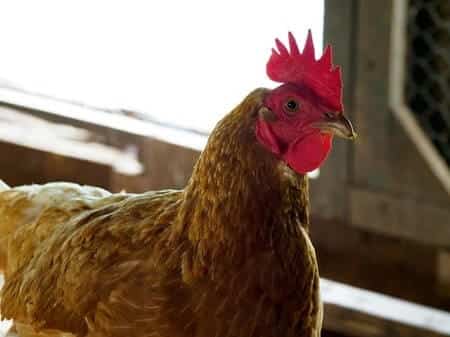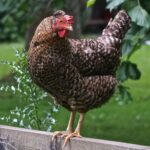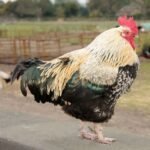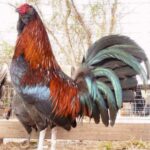ISA Brown Chickens were bred to produce a lot of eggs, and as a result, have short lifespans. In commercial settings, they typically have a life expectancy of 2-3 years. As well-treated backyard pets, it’s not uncommon for them to live 4-5 years.
Table of Contents
How Long Do ISA Browns Live For?
ISA browns live for anywhere between 2-5 years. As hybrids, the length of their lives are a lot shorter than heritage chickens. Which is the name given to breeds that have been raised and bred naturally with their own kind.
This is because ISA Browns are crossbreeds carefully bred over time to be profitable dual-purpose birds. They were created back in 1978 by a company called the Institut de Sélection Animale (ISA).
Although that company later merged with another company called Merck & Co., exactly how and by which breeds the ISA Brown was created is a closely guarded secret.
They were bred to produce a lot of eggs in a short space of time, and that’s what ISA Browns do. They are capable of laying 300+ eggs in their first year of laying, this then drops over the next two years until they are no longer able to lay.
So, in a commercial setting where they are typically put under stress to lay a lot of eggs, their lifespan is on the shorter end of 2-3 years.
When kept as backyard pets and treated well, I’ve read accounts from owners saying their ISAs lived a happy and healthy 4-5 years.
Things That Affect a Chicken's Life Expectancy
Genes have a lot to do with how long a chicken is expected to live. However, the better their living conditions, the longer you can expect chickens in a backyard setting to live (much like us!).
Some of the factors that have a big impact on a chicken’s life expectancy include:
Housing
Chickens that have a spacious, comfortable, coop are going to be healthier and live longer. Don’t worry, comfy to chickens doesn’t mean nice soft padding. It means clean, cool in the summer, warm in the winter, and safe from predators.
To help you get a better understanding of how much space you need, please read - How many chickens can you put in a 4x8 coop?
Diet
Obviously, diet has a huge impact on how healthy your ISA Browns will be and their quality of life.
Ideally, you should feed your chickens a diet consisting mostly of quality commercial feed. In addition to this, allowing them to roam free-range and scratch for bugs and bits of plants enhances their diet.
You can also add some variation and boost their nutritional intake by adding some leftover fruits and vegetables. Just be sure to always check any table scraps you give them are safe.
Disease
Generally speaking, there aren’t a lot of diseases that affect backyard chickens if they’ve been contained and free from disease.
Chicken lice, mites, worms, and various types of parasites are the main issues. Gapeworm is one of the worst. This worm gets into the trachea of a chicken and disrupts a chicken’s breathing.
While you can’t always avoid parasites infiltrating your flock, you can take action as soon as you suspect there is an issue.
Related - You can look for avian vets near you here.
How Old Are Isa Browns When They Start Laying Eggs?

It’s always hard to pinpoint when a chicken is going to lay their first egg. What we do know about ISAs, however, is that they typically mature sooner than most breeds.
This is no coincidence. ISA Brown chickens were selectively bred to be great layers. As I explained, exactly how they were bred is a closely guarded secret. But the result is a chicken that typically comes into lay at around 5 months of age.
I’ve heard loads of owners say that they started to see those first small ‘pullet eggs’ at around 16-18 weeks (4-5 months), which is incredible, really.
When you compare this to other great layers, like the Delaware that starts to lay at around 24-28 weeks. Or, Rhode Island Reds that tend to be nearer to 20-22 weeks of age. You can see, there are often a good few weeks between ISAs and those breeds.
You can expect pullet eggs for 4 or so weeks. This is normal, and what you expect from most breeds of chicken. Pullet eggs are smaller than regular eggs, and they will sometimes also be a little odd-shaped.
Although everyone is surprised the first time they see a pullet egg, it makes sense. Chickens can’t just start laying the perfect eggs on their first few attempts!
Keeping ISA Browns as Backyard Pets
ISA Browns are one of the most unique and interesting chickens. One of the unique things is that ISA is not a breed, rather it’s a copyrighted brand name.
Still, I look at ISAs as a breed. There are other breeds that look similar, act similar, but there’s no mistaking that ISA Browns are different from other breeds.
Something you’ll see most owners talk about is their personality. ISA Browns are incredibly friendly and social. If you’re looking for chickens that you can spend some time with, they’re a great choice.
They are also very durable and hardy. ISA Browns adapt to extreme weather conditions, they love roaming around, and are generally healthy.
The most obvious reason why they’re a great choice as pets is for their egg-laying prowess. You just need a small number of ISAs in your flock and you’re going to have more eggs than you can handle.
They also lay well throughout the winter months. At, least more so than you would expect from other breeds. So, tell your neighbors, friends, and family to expect plenty of eggs if you’re raising ISA Browns!
Resources
Image credits - Header photo by Thomas Park on Unsplash




